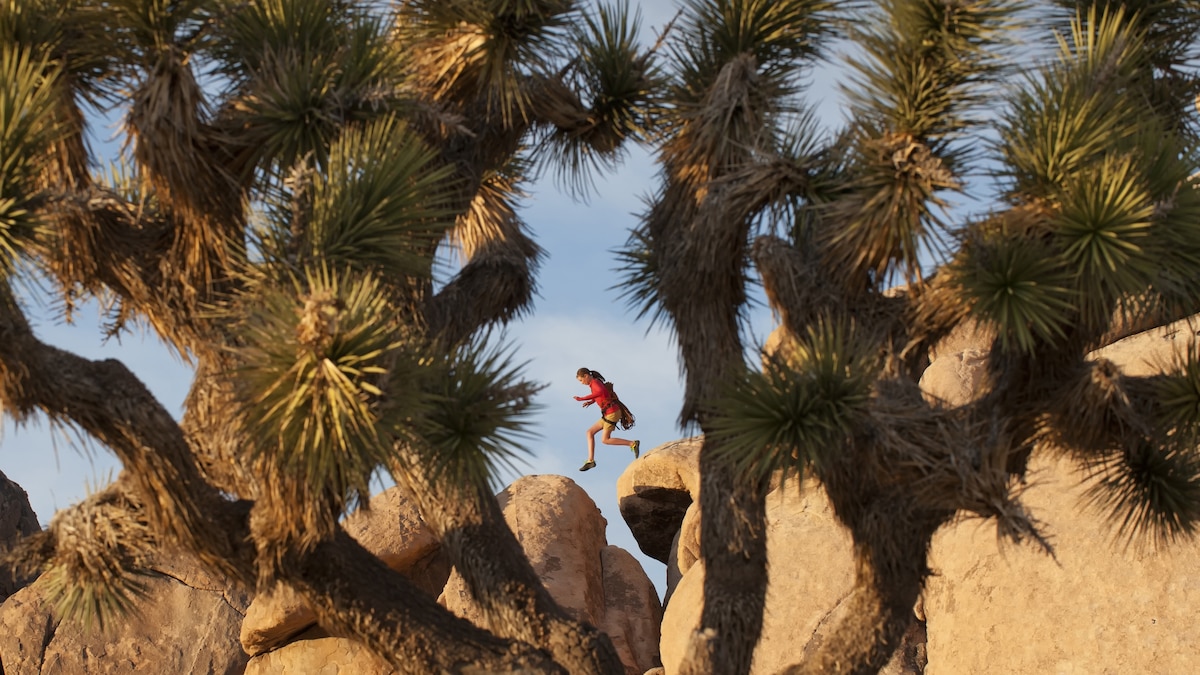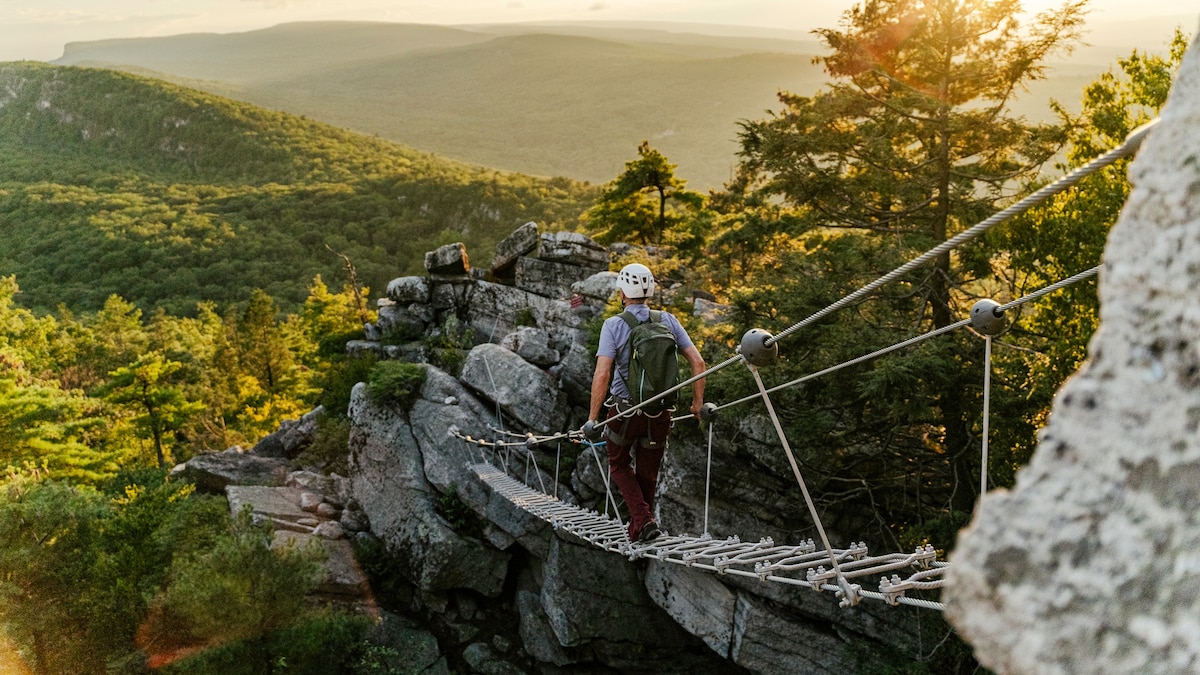Now Reading: The best Joshua Tree hikes for wanderers and wildlife watchers
-
01
The best Joshua Tree hikes for wanderers and wildlife watchers
The best Joshua Tree hikes for wanderers and wildlife watchers

Like many national parks, Joshua Tree National Park offers a wide range of trails at all levels of hiking expertise and ability. No matter which route you choose or time of year you decide to visit, always remember that this national park is a desert.
Sunscreen, a hat, ample water, and a flashlight for night hikes are required even on shorter hikes. On longer jaunts, pack energy snacks, and a portable first-aid kit in case you have an unexpected run-in with a cactus or wildlife. Due to the lack of reliable cell phone service in the park, download your hiking route to GPS before setting off.

Despite the arid climate in Joshua Tree, these Mojave gold poppies are in full bloom despite arid conditions found in both the Mojave and Sonoran Deserts of California.
Photograph by Kent Kobersteen, Nat Geo Image Collection
The best time to hike in Joshua Tree National Park
Joshua Tree National Park is utterly oppressive during the summer when midday temperatures frequently hover above 100°F. Winter means cooler days (around 60°F), freezing nights, and the possibility of strong winds and even snow at the park’s higher elevations.
However, spring and fall are ideal for Joshua Tree hikes in the Mojave Desert—the blue skies, gentle breeze, very little chance of rain, an average high of 85°F, and a low of 50°F. Hiking in the spring also brings the possibility of catching the wildflowers in bloom, which usually starts in January or February at lower elevations and reaches a park-wide peak in April through June.
“October through May is our busiest time of year, especially holiday weekends,” says Donovan Smith, the park’s public information officer. Entrance station lines are often longer, and parking lots can fill up as early as 8 a.m., according to Smith. So, get there early to hike one of the more popular trails.
(Everything you need to know about Joshua Tree National Park)

A woman hikes into the Wonderland of Rocks, a 12-square-mile area in Joshua Tree National Park known for its maze of massive granite rock formations.
Photograph by Tom Grundy, Alamy
Where to find the best Joshua Tree hikes
Easy Joshua Tree trails
Three short nature trails in the heart of the park—Hidden Valley, Barker Dam, and Cap Rock—are a great introduction to Joshua Tree’s natural and human history. The these short hikes are a mile or less in distance and take anywhere from 30 minutes to an hour.
Take the super-short walk from the parking lot to the overlook at Keys View. Just 0.2 miles in length, the loop trail leads to one of the most iconic panoramas in the entire National Park System: A mile-high vista of Coachella Valley with the Salton Sea, Mount San Jacinto, the San Andreas Fault, and Anza-Borrego Desert in the background. The view is especially enchanting at dusk when Palm Springs, Indio, and other valley cities sparkle with millions of lights. The trail is also wheelchair accessible.
Intermediate and advanced Joshua Tree trails
The eight-mile Boy Scout Trail into the boulder-strewn Wonderland of Rocks (a maze of boulder and rock formations) and the 36-mile California Riding & Hiking Trail—normally done as a two- or three-day backpack trip—are among the more challenging trails accessed from the Hidden Valley area.
Great hikes in the Cottonwood area include the three-mile route to Mastodon Peak and the seven-point-five-mile trek to remote Lost Palms Oasis. And just off Park Boulevard, the three-mile, out-and-back trail to the summit of 5,456-foot Ryan Mountain renders bird’s-eye-views of Hidden Valley, Queen Valley, and Jumbo Rocks.
(8 family-friendly things to do in Joshua Tree)
Where to see wildlife in Joshua Tree
Several critters inhabit Joshua Tree’s cactus and boulder-strewn landscapes. Most of them are small and well-camouflaged for the desert environment, and most are active after dark, making them hard to spot.

A coyote sneaks up on its prey in California’s Mojave Desert.
Photograph by Ron Niebrugge, Alamy

Audubon’s cottontail, also known as a desert cottontail, is spotted in Hidden Valley at Joshua Tree National Park.
Photograph by Michael Weber, Alamy
Evolutionary biologist and National Geographic Explorer David M. Althoff, who studies insects in the park, says that many people view Joshua Tree and similar areas of the California desert as dry wastelands. “But if you stop and examine the organisms living there, you realize there is a myriad of amazing creatures. As a scientist, I see these areas as great examples of how evolution can adapt organisms to some really inhospitable places (for humans at least).”
Keys View, Wonderland of Rocks, and Queen Mountain north of Hidden Valley are the best places for spotting desert bighorn sheep, the park’s largest mammal.
(The best places to stay at Joshua Tree National Park.)

Visitors hiking on Split-Rock Trail in Joshua Tree may spot wildlife like this desert bighorn sheep. Be sure to keep a safe distance from any and all wildlife in the park.
Photograph by Michael S. Nolan, Alamy
Otherwise, it’s a case of being in the right place at the right time. Given the fact that desert animals are more active at night, the best times to spot wildlife are dusk and dawn. Look for jackrabbits and roadrunners around campgrounds, ground squirrels around boulders, and lizards along just about any trail.
Places with water and vegetation—the Oasis of Mara, Barker Dam, Desert Queen Ranch, and Cottonwood Spring—are best for birdwatching. Turkey vultures, kestrels, golden eagles, and red-tailed hawks are among the species that are easiest to spot without binoculars.
No matter what creature you come across, always keep a safe distance. Not just for your safety but for the well-being of the animal too. And always look down when you’re walking to avoid an unexpected run-in with a rattlesnake.
(How to do wildlife tourism right and be a responsible traveler.)























